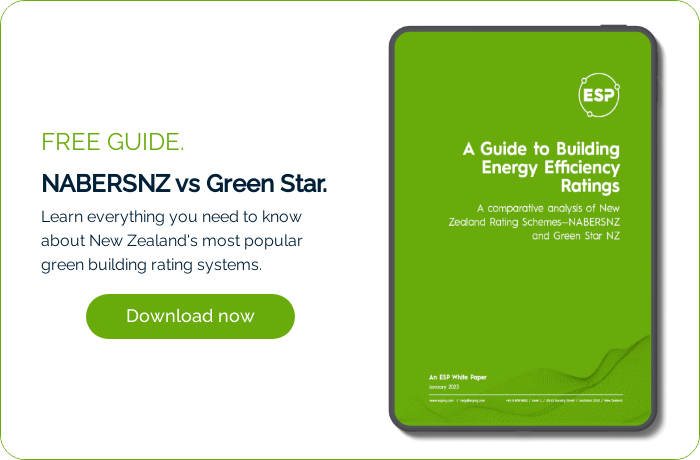
News, Release Radar
How to build a business case for NABERSNZ for property & facility managers
NABERSNZ is a powerful accreditation that proves the energy efficiency and sustainability of your buildings – but before you can secure a rating, you’ll need to secure some budget with a convincing business case.
Below, you’ll find a full guide to building a business case for NABERSNZ, including the structure, format, specifics, resources and useful datapoints to drive your point home.
Part 1: Problem and business need.
This section of the business case is essentially describing why you’re putting forward these ideas. You must define the specific problems that the business is facing, as well as explain why they are problems. This is building the foundation for the rest of your business case, particularly the next section, which will describe how a NABERSNZ rating is a solution.
Your goal is to demonstrate that the business environment has changed, and is continuing to change, and successful companies must adapt to the increased focus on sustainability and energy efficiency.
Here are some problems and business needs you could highlight:
- Legislation risk. Local, national, and international laws are changing to require businesses to prove the energy efficiency of their processes, products and properties. Falling behind on these obligations is a compliance risk for your business.
- Stakeholder scrutiny. Investors, tenants and industry bodies have ever increasing sustainability expectations. Failing to prove competency can lead to reputational damage with knock-on effects that can impact revenue and growth.
- Greenwashing. Where you are already taking action and making improvements, do you have a water-tight story supported by data? Greenwashing accusations around ratings & reporting are already affecting the landscape.
- Increasing utility costs. Average commercial utility costs have been steadily increasing since 2017, with 2021 to 2022 seeing a particularly large jump, steadily taking a bigger slice of operational expenses.
- Lack of benchmarking. Energy efficiency projects must be guided by accurate, meaningful data. Without the correct insights, the business will only be taking ‘best guesses’ at what will move the dial.
Your specific needs and challenges will dictate which of these will be emphasised, but generally speaking, all business cases for NABERSNZ will benefit from mentioning the benchmarking factor. This is a key part of the NABERSNZ value proposition, and tends to resonate well with stakeholders, regardless of other context.
Part 2: Benefits and risks of the options.
In this section, you’ll be providing solutions to the problems you just presented. You will offer some options and provide balanced evaluations around each. This is a good opportunity to show that you have considered multiple different avenues to tackling these challenges and will help to prevent pushback based on seeking alternatives.
Your goal here is to illustrate the potential paths ahead in solving these issues and effectively demonstrate why a green building rating, specifically NABERSNZ, would be beneficial to the property portfolio.
Here are some broad points you can make about green building ratings as a solution:
- De-risking around future requirements. The proposed Building Act amendments highlight how governments may make energy efficiency ratings mandatory from 2024. Securing a rating now will help you get ahead of the competition and reduce the risk of waiting until the last minute.
- Verifiable green credentials. Properties with accredited green credentials stand out in the crowd, attracting more and higher quality tenants compared to non-accredited counterparts.
- Reduced operational costs. While green building ratings don’t improve energy efficiency in themselves, they provide insights into what can and should be changed to improve the rating and, thus, the energy efficiency of the building.
- Foundational data. Official green building ratings must be performed by an independent assessor, ensuring that the data you gather as part of the assessment is accurate and meaningful. This provides the foundational baseline you need to work from to improve building performance.
NABERSNZ alternatives
NABERSNZ isn’t the only green building rating available. Here are some of the others you could present:
- Green Star.
- BREEAM.
- LEED.
- GRESB.
We have a breakdown of each of these in our NABERSNZ vs Green Star guide.
Why NABERSNZ?
Now is the time to briefly explain how NABERSNZ works: a 1 to 6 star rating, based on energy efficiency performance over the last 12 months, assessed by a licensed third party. For more detail, we suggest taking a look at our free NABERSNZ webinar or the Know your NABERSNZ writeup.
Here are some points you can make on why you’ve settled on NABERSNZ as the best choice:
- Overseas proof, NZ-adapted. NABERSNZ was originally imported from Australia, where it has been in operation for more than 20 years. In that time, it has saved AUD$1billion in energy bills, 7 million in CO2, 6 billion litres of water, and 78% of Australia’s office spaces are now rated with NABERS.
- Office specific. At the time of writing, NABERSNZ is designed specifically for existing office buildings. This means that it focuses heavily on those aspects most important to office building owners and investors, providing more accurate data and the ability to customise the rating based on use (see the difference between basebuild, whole building and tenancy ratings on our NABERSNZ page).
- Government-recognised and -required. Since 2021, any property seeking a Government department tenancy must have a current and high-performing NABERSNZ rating. This limits the field, allowing buildings with good ratings to secure strong, blue-chip and long-term Government tenancies.
- Energy efficiency focus. While other green building ratings take a broad view in their assessment, NABERSNZ focuses specifically on energy efficiency. This narrow beam ensures that you are only assessed on the aspect that matters most to your building performance.
Once again, depending on your individual circumstances, add, focus on or eliminate these points as necessary.
Lastly, there are several different kinds of NABERSNZ rating, suitable for different types of occupants. Ensure that you highlight which you are recommending and why. They are:
- Base Building. This measures the energy performance of a building’s core services only, such as lifts, common toilets, air conditioning, ventilation, and similar.
- Tenancy. This measures only the energy efficiency of the building space exclusively used by a single tenant, such as computers, floor-specific lighting, data centres and staff kitchens.
- Whole Building. This measures a combination of both Base Building and Tenancy ratings.
Part 3: Process and ROI
Now that you have settled on a specific solution in your business case, it’s time to cover the financial and process aspects of your intended project. This will provide stakeholders with a better understanding of what the business will gain from their investment and demonstrate that it will have a net gain. This is also a good time to provide an overview of timelines and the process involved.
Here are some points to cover for a NABERSNZ business case:
- Costs. A NABERSNZ assessment can cost anywhere between $2,000 and $4,000, depending on the type of rating and size of the building in question. Re-assessments are generally less expensive.
- Process. Assessments can take between X and Y weeks to perform and require at least 12 months of utility data from the property. The process itself is relatively straightforward, with most of the work being done by the assessor.
- Minimal disruption. NABERSNZ assessments are relatively non-disruptive, though this depends on the expertise and competency of your assessor. Assessments must be performed at least once every year for the rating to remain current.
- Improvements. NABERSNZ ratings don’t improve energy efficiency directly, but rather highlight areas for improvement. Some of these require only small investments, such as replacing bulbs with LED lighting, but others (such as swapping out boilers), may have larger impacts and larger costs. This will be easier to estimate once you have the initial rating.
Return on investment is a significant consideration for a business case – possibly the most important part of all. Here are some points to make:
- Property value. Buildings with a 4.5 star NABERS rating in Australia saw an 8 per cent premium on sales price compared to non-rated buildings. Higher ratings saw an even larger jump of up to 18 per cent.
- Cost savings. A higher-rated building is more efficient, lowering operational expenses and freeing up capital for projects elsewhere. NABERSNZ ratings must be updated every year to remain valid, any building that invests in this green building rating will naturally be encouraged to regularly review, update, and improve performance to enhance efficiency. For example, ASB saw a 49% reduction in CO2 emissions following a robust energy efficiency plan with us that included NABERSNZ ratings.
- Non-tangible benefits. NABERSNZ provides better branding opportunities, the chance to secure Government tenancies, increase investor awareness, align the property with corporate sustainability goals, and more. It is difficult to provide an exact ROI of these aspects, but they are valuable nonetheless.
You can read more about how a NABERSNZ rating improves ROI on our dedicated guide.
Part 4: Final recommendation
Here is where you’ll summarise your findings and present a succinct recommendation. Here’s an example you can base your final statement on:
A NABERSNZ rating offers a straightforward, fast, cost-efficient green building rating that will derisk for the future, get the data we need to improve our energy efficiency, and demonstrate to stakeholders that we have a commitment to sustainability.
Of the options in front of us, NABERSNZ is the best choice because it is cost-effective, internationally recognised, Government-backed, office-specific, and focuses specifically on energy efficiency. No other alternative offers the same set of benefits.
Useful resources for your business case
Be ready to field some questions about NABERSNZ and why it will be a net positive for your business. You may find the below resources useful:
- Article: How a NABERSNZ Rating Improves ROI
- Article: 3-Star VS. 4-Star NABERSNZ Ratings
- Article: New amendments may make energy efficiency ratings mandatory for business owners from 2024
- Case study: ASB Receives 4.5 Star NABERSNZ Rating
- Guide: NABERSNZ vs Green Star: A Guide to Building Energy Efficiency Ratings
- Guide: Looking for a NABERSNZ Supplier
- Webinar: Know your NABERSNZ
Want to learn more about the costs, benefits and process of a NABERSNZ rating? Book a meeting with our expert team for a quick chat around everything you need to know to build your business case.

